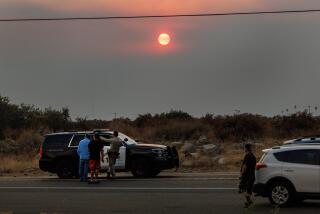The Smokies Beginning to Look a Lot Like L.A.
BRYSON CITY, N.C. — On certain days high in the Great Smoky Mountains, Jim Renfro knows better than to work out too strenuously. His home offers scenic vistas of green mountains and blue sky--and some of the worst air pollution in the United States.
“I live on a ridge top, and I tend to stay in on those really bad days,” said Renfro, air resource specialist at Great Smoky Mountains National Park in Gatlinburg, Tenn. “I can tell I’m not getting a full breath of fresh air like I should. I can smell the difference, I can feel the difference.”
These days, the venerable old mountains might as well be called the Great Smoggies.
Here, in the land of the black bear, the Cherokee Indian and Dolly Parton, is the most frequently visited of all 52 U.S. national parks. But too often, the 10 million annual tourists cannot even see what they came to look at: A thick haze envelops the peaks, sometimes reducing visibility to a mile.
“People assume when you go to a national park, you’re getting away from the dirty air of the cities,” said Don Barger, southeast regional director of the National Parks Conservation Assn. “We’re dealing with a situation where the very reasons people go to national parks are being damaged.”
Some days, the air pollution in the Smokies is worse than in Atlanta, nicknamed the “Los Angeles of the East.” But the trouble hardly ends there.
Although U.S. air quality overall has improved, the South has become the nation’s new trouble spot for air pollution. In the 1990s, it was among the fastest-growing areas in the country, and with that growth has come a downside.
More people have meant more cars--and more sport-utility vehicles with higher emissions, said Jeff Clark, policy director with the Environmental Protection Agency’s Office of Air Quality Planning and Standards. Sprawling cities mean longer commutes, Clark said. Demand has soared for air conditioning, much of it made possible by coal-fired utility plants with tall smokestacks. Then there is nature’s contribution: The region’s hot summers and often stagnant air encourage smog accumulation.
Declining air quality in the South, and in the Great Smokies in particular, has become an environmental and public health concern, and something of a political issue. Elected officials, state and federal agencies, worried residents and utility companies have put their heads together to seek solutions to a problem that everyone concedes wasn’t created overnight.
“Most of the states are interested in ensuring that their national parks are well-protected, with the added objective to make sure our thriving economy in the Southeast continues to thrive,” said Tom Elmore, director of the Southern Appalachian Mountains Initiative, which has eight states participating in a study of pollution’s effects on the region’s ecosystem.
Elmore said SAMI is working on a $4-million computer model that will look at emissions across the eastern United States, from power plants, motor vehicles, dry cleaners and so on, moving them through weather patterns to determine the effect on the Smokies. The study will be completed next spring.
Meanwhile, the governors of Tennessee and North Carolina are urging Georgia Gov. Roy Barnes to join a regional clean-air pact that would allow national park officials to review permits for industries that might add to the pollution.
Utility companies continue to employ new technology to try to reduce pollutants. The Tennessee Valley Authority, the country’s largest public electricity producer with 8 million consumers and 11 coal-fired plants, already has spent more than $2.6 billion on such innovations. The EPA continues to push for stricter standards; recently, a federal appeals court upheld an EPA order forcing 19 eastern states to reduce ozone-forming nitrogen oxides, largely affecting power plants, Clark said. In December, the agency issued an order that will reduce emissions from new sport-utility vehicles.
Beautiful as they are, the Great Smoky Mountains are uniquely situated to catch the most bad air much of the time. The national park straddles the North Carolina-Tennessee border, and some of its peaks reach more than 6,000 feet.
“A lot of factors predispose this park,” said Renfro, who has monitored air quality here since 1979. “One is elevation--we stick out like a sore thumb. Air pollution can come from any direction . . . and we intercept the pollutants. They tend to deposit into the trees, the soils, the streams.”
Long ago, the Cherokees called this region “the Land of Blue Mists,” and the Smokies got their name from the watery smoke that rises from the mountains after a rainfall--not the same as the “chemical soup” that often blocks visibility and impairs breathing.
Summertime not only has the heaviest tourist influx but is also the height of the ozone season. Scientists differentiate between good ozone, the atmospheric variety everyone wants to preserve, and ground-level ozone, a colorless gas that is the primary ingredient in smog. This type of ozone “cooks” during the day, Barger said, and can result in a condition he calls “sunburn on the lungs.”
Last year, Great Smoky Mountains National Park had a record 52 unhealthy ozone pollution days, Renfro said. So far this year, the park has had 14 such days, which is ahead of last summer’s pace.
“If you look at average daily exposure of ozone, it is two times higher over the ridge tops of the Appalachian Mountains, as opposed to lower elevations, like Washington, D.C., or Atlanta,” he said.
More to Read
Sign up for Essential California
The most important California stories and recommendations in your inbox every morning.
You may occasionally receive promotional content from the Los Angeles Times.










